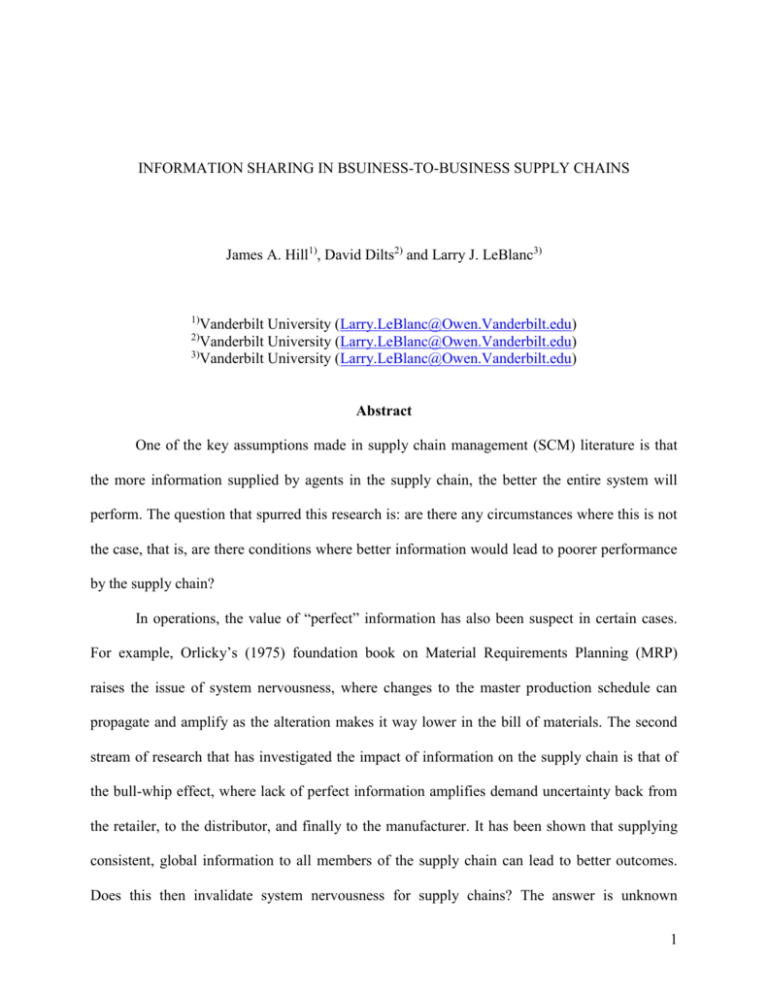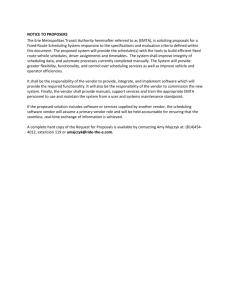LeBlanc, Larry Joseph
advertisement

INFORMATION SHARING IN BSUINESS-TO-BUSINESS SUPPLY CHAINS James A. Hill1), David Dilts2) and Larry J. LeBlanc3) 1) Vanderbilt University (Larry.LeBlanc@Owen.Vanderbilt.edu) Vanderbilt University (Larry.LeBlanc@Owen.Vanderbilt.edu) 3) Vanderbilt University (Larry.LeBlanc@Owen.Vanderbilt.edu) 2) Abstract One of the key assumptions made in supply chain management (SCM) literature is that the more information supplied by agents in the supply chain, the better the entire system will perform. The question that spurred this research is: are there any circumstances where this is not the case, that is, are there conditions where better information would lead to poorer performance by the supply chain? In operations, the value of “perfect” information has also been suspect in certain cases. For example, Orlicky’s (1975) foundation book on Material Requirements Planning (MRP) raises the issue of system nervousness, where changes to the master production schedule can propagate and amplify as the alteration makes it way lower in the bill of materials. The second stream of research that has investigated the impact of information on the supply chain is that of the bull-whip effect, where lack of perfect information amplifies demand uncertainty back from the retailer, to the distributor, and finally to the manufacturer. It has been shown that supplying consistent, global information to all members of the supply chain can lead to better outcomes. Does this then invalidate system nervousness for supply chains? The answer is unknown 1 because, as Pujawan and Kingsman (2000) state, there is virtually no literature that addresses whether systems nervousness exists from one channel to another in a supply chain. A third area that has evaluated the impact of information quality and sharing in a number of settings is the information systems field. In his classis article “Management Misinformation Systems”, Ackoff (1969) proposed that supplying information to all parties does not lead to better decisions. His work has been built upon by a number of information systems researchers who have arrived at mixed results. From an industrial perspective, unstable information is not uncommon. For example, it is common for an automotive supplier to be presented with a production order that specifies exact parts only days before due dates. The supplier may be on contract to supply a certain number of parts, but the exact numbers to be supplied can vary dramatically. This study investigates the delivery of identical information through out a multilevel supply chain and the impact that unstable information has on the performance of the supply chain. Using simulation, we quantify the benefits of sharing information in terms of faster fulfillment of customer orders. We also show that an uncoordinated approach to supply-chain management using information technology can result in worse performance than a much simpler system with no information sharing. For example, consider the following scenario. Individual customers order end items from an OEM which waits until orders for 100 or more end items have accumulated before ordering materials from its vendor. The vendor’s operations research department has determined that its optimal production lot size is 1,100 units. The vendor’s marketing and finance departments stress the importance of production only in anticipation of OEM orders, that is, when the OEM is close to placing an order to the vendor. The OEM provides this information on its total customer orders status in real time to the vendor. The vendor quantifies “OEM is close to ordering” as “OEM has individual customer 2 orders totaling 95 end items.” Each end item requires 10 units of the vendor’s materials. When the vendor observes a total of 95 individual customer orders for end items at the OEM, the vendor proceeds to produce its batch of 1,100 units. This is sufficient for the OEM’s usual order of 100 end items @ 10 vendor units = 1,000 units plus a safety factor in case the OEM orders more than usual. Vendor policy is to produce only when the OEM is close to placing a firm order to the vendor to avoid the inventory costs associated with the large batch of 1,100 units. Later, the OEM orders materials for 130 end items from the vendor, which is much higher than usual. This requires 130 end items @ 10 units each = 1,300 units from the vendor. However, the vendor has available only 1,100 units. Furthermore, according to the production policy the vendor does not produce again until the OEM is nearly ready to order again. This requires waiting until the OEM has received orders for another 95 end items (a total of 95 + 95 = 190 end items) before producing materials sufficient for the original 130-end item order. This delay causes the first order of 130 end items to wait much longer than if there was no information given to the vendor. That is, if the vendor simply waited for a firm order for materials for 130 end items (instead of 190 end items) was received from the OEM, then the initial order of 130 end items would be filled much faster. The underlying cause of this problem is the lack of coordination between the OEM and the vendor, which resulted in an inappropriate batch size. 3 OEM Vendors Sub-Vendors Figure 1: Three Manufacturing Tiers in a Supply Chain Our simulation models uses the three-level production system shown in Figure 1. Different models treat the case of information sharing within the chain and no information sharing. 4







